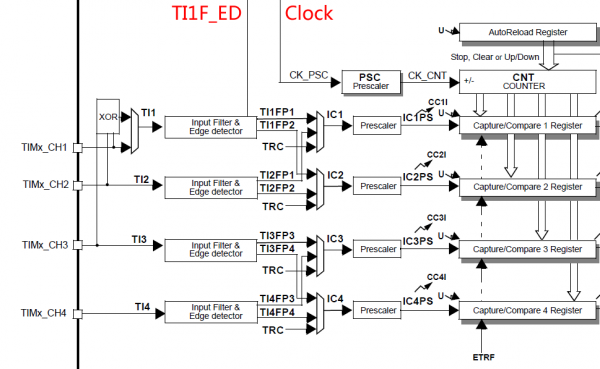STM32輸入捕獲模式設(shè)置并用DMA接收數(shù)據(jù)
參考:STM32的PWM輸入模式設(shè)置并用DMA接收數(shù)據(jù)
Input capture mode
The input stage samples the corresponding TIx input to generate a filtered signal TIxF.
本文引用地址:http://cafeforensic.com/article/201611/318505.htmThen, an edge detector with polarity selection generates a signal (TIxFPx)
which can beused as trigger input by the slave mode controller or as the capture command.
It isprescaled before the capture register (ICxPS).


In Input capture mode, the Capture/Compare Registers (TIMx_CCRx) are used to latch thevalue of the counter
after a transition detected by the corresponding ICx signal.
When acapture occurs, the corresponding CCXIF flag (TIMx_SR register) is set and an interrupt
ora DMA request can be sent if they are enabled.
If a capture occurs while the CCxIF flag wasalready high, then the over-capture flag CCxOF (TIMx_SR register) is set.
CCxIF can becleared by software by writing it to ‘0’ or by reading the captured data stored in theTIMx_CCRx register.
CCxOF is cleared when you write it to ‘0’.
The following example shows how to capture the counter value in TIMx_CCR1 when TI1input rises.
To do this, use the following procedure:
? Select the active input:
TIMx_CCR1 must be linked to the TI1 input, so write the CC1Sbits to 01 in the TIMx_CCMR1 register.
As soon as CC1S becomes different from 00,the channel is configured in input and the TIMx_CCR1 register becomes read-only.
? Program the input filter duration you need with respect to the signal you connect to thetimer
(by programming ICxF bits in the TIMx_CCMRx register if the input is a TIx input).
Let’s imagine that, when toggling, the input signal is not stable during at must 5 internalclock cycles.
We must program a filter duration longer than these 5 clock cycles.
Wecan validate a transition on TI1 when 8 consecutive samples with the new level havebeen detected (sampled at fDTS frequency).
Then write IC1F bits to 0011 in theTIMx_CCMR1 register.
? Select the edge of the active transition on the TI1 channel by writing CC1P and CC1NPbits to 0
in the TIMx_CCER register (rising edge in this case).
? Program the input prescaler. In our example, we wish the capture to be performed ateach valid transition,
so the prescaler is disabled (write IC1PS bits to ‘00’ in theTIMx_CCMR1 register).
? Enable capture from the counter into the capture register by setting the CC1E bit in theTIMx_CCER register.
? If needed, enable the related interrupt request by setting the CC1IE bit in theTIMx_DIER register,
and/or the DMA request by setting the CC1DE bit in theTIMx_DIER register.
When an input capture occurs:
? The TIMx_CCR1 register gets the value of the counter on the active transition.
? CC1IF flag is set (interrupt flag). CC1OF is also set if at least two consecutive capturesoccurred whereas the flag was not cleared.
? An interrupt is generated depending on the CC1IE bit.
? A DMA request is generated depending on the CC1DE bit.
In order to handle the overcapture, it is recommended to read the data before theovercapture flag.
This is to avoid missing an overcapture which could happen after readingthe flag and before reading the data.
Note:
IC interrupt and/or DMA requests can be generated by software by setting thecorresponding CCxG bit in the TIMx_EGR register.
STM32輸入捕獲模式設(shè)置并用DMA接收數(shù)據(jù)
本文博客鏈接:http://blog.csdn.net/jdh99,作者:jdh
環(huán)境:
主機(jī):WIN7
開(kāi)發(fā)環(huán)境:MDK4.72
MCU:STM32F103
說(shuō)明:
項(xiàng)目中需要進(jìn)行紅外學(xué)習(xí),于是采用輸入捕獲取得電平變化時(shí)間.并將數(shù)據(jù)放在DMA中.這樣可以避免頻繁中斷消耗CPU資源.
采用的是PB1腳,對(duì)應(yīng)TIM3的通道4.
/********************************************************************** 接口函數(shù):初始化紅外學(xué)習(xí)模塊**********************************************************************/void inf_infrared_study_init(void){//初始化io口inf_init_io();//初始化中斷//inf_init_irq();//初始化定時(shí)器inf_init_timer();//打開(kāi)DMAinf_infrared_study_open_dma(1);//打開(kāi)定時(shí)器inf_infrared_study_open_timer(1);}/********************************************************************** 初始化io口**********************************************************************/static void inf_init_io(void){//定義IO初始化結(jié)構(gòu)體GPIO_InitTypeDef GPIO_InitStructure;//初始化時(shí)鐘RCC_APB2PeriphClockCmd(RCC_APB2Periph_GPIOB,ENABLE);//管腳初始化 GPIO_InitStructure.GPIO_Pin = GPIO_Pin_1;//設(shè)置為輸入 GPIO_InitStructure.GPIO_Mode = GPIO_Mode_IN_FLOATING; //初始化 GPIO_Init(GPIOB, &GPIO_InitStructure); }/********************************************************************** 初始化中斷**********************************************************************/static void inf_init_irq(void){//定義外部中斷結(jié)構(gòu)體EXTI_InitTypeDef EXTI_InitStructure;//初始化中斷腳復(fù)用時(shí)鐘RCC_APB2PeriphClockCmd(RCC_APB2Periph_AFIO,ENABLE);//配置中斷源GPIO_EXTILineConfig(GPIO_PortSourceGPIOB,GPIO_PinSource1);// 配置下降沿觸發(fā)EXTI_ClearITPendingBit(EXTI_Line1);EXTI_InitStructure.EXTI_Line = EXTI_Line1;EXTI_InitStructure.EXTI_Trigger = EXTI_Trigger_Falling;EXTI_InitStructure.EXTI_Mode = EXTI_Mode_Interrupt;EXTI_InitStructure.EXTI_LineCmd = ENABLE;EXTI_Init(&EXTI_InitStructure);}/********************************************************************** 初始化定時(shí)器**********************************************************************/static void inf_init_timer(void){//定義定時(shí)器結(jié)構(gòu)體TIM_TimeBaseInitTypeDef timInitStruct;//輸入捕獲結(jié)構(gòu)體TIM_ICInitTypeDef tim_icinit;//定義DMA結(jié)構(gòu)體DMA_InitTypeDef DMA_InitStructure;//啟動(dòng)DMA時(shí)鐘RCC_AHBPeriphClockCmd(RCC_AHBPeriph_DMA1, ENABLE);//DMA1通道3配置DMA_DeInit(DMA1_Channel3);//外設(shè)地址DMA_InitStructure.DMA_PeripheralBaseAddr = (uint32_t)(&TIM3->CCR4);//內(nèi)存地址DMA_InitStructure.DMA_MemoryBaseAddr = (uint32_t)Rx_Buf_Tim_Dma;//dma傳輸方向單向DMA_InitStructure.DMA_DIR = DMA_DIR_PeripheralSRC;//設(shè)置DMA在傳輸時(shí)緩沖區(qū)的長(zhǎng)度DMA_InitStructure.DMA_BufferSize = RX_LEN_TIM_DMA;//設(shè)置DMA的外設(shè)遞增模式,一個(gè)外設(shè)DMA_InitStructure.DMA_PeripheralInc = DMA_PeripheralInc_Disable;//設(shè)置DMA的內(nèi)存遞增模式DMA_InitStructure.DMA_MemoryInc = DMA_MemoryInc_Enable;//外設(shè)數(shù)據(jù)字長(zhǎng)DMA_InitStructure.DMA_PeripheralDataSize = DMA_PeripheralDataSize_HalfWord;//內(nèi)存數(shù)據(jù)字長(zhǎng)DMA_InitStructure.DMA_MemoryDataSize = DMA_MemoryDataSize_HalfWord;//設(shè)置DMA的傳輸模式//DMA_InitStructure.DMA_Mode = DMA_Mode_Normal;DMA_InitStructure.DMA_Mode = DMA_Mode_Circular;//設(shè)置DMA的優(yōu)先級(jí)別DMA_InitStructure.DMA_Priority = DMA_Priority_High;//設(shè)置DMA的2個(gè)memory中的變量互相訪問(wèn)DMA_InitStructure.DMA_M2M = DMA_M2M_Disable;DMA_Init(DMA1_Channel3,&DMA_InitStructure); //開(kāi)啟時(shí)鐘RCC_APB1PeriphClockCmd(RCC_APB1Periph_TIM3,ENABLE);//重新將Timer設(shè)置為缺省值TIM_DeInit(TIM3);//采用內(nèi)部時(shí)鐘給TIM3提供時(shí)鐘源TIM_InternalClockConfig(TIM3);//預(yù)分頻timInitStruct.TIM_ClockDivision = TIM_CKD_DIV1; //計(jì)數(shù)頻率為500ns跳轉(zhuǎn)1次 timInitStruct.TIM_Prescaler = SystemCoreClock / 2 - 1; //向上計(jì)數(shù) timInitStruct.TIM_CounterMode = TIM_CounterMode_Up; timInitStruct.TIM_RepetitionCounter = 0;//這個(gè)值實(shí)際上就是TIMX->ARR,延時(shí)開(kāi)始時(shí)重新設(shè)定即可 timInitStruct.TIM_Period = 0xffff; //初始化定時(shí)器3TIM_TimeBaseInit(TIM3, &timInitStruct);//輸入捕獲配置//選擇通道tim_icinit.TIM_Channel = TIM_Channel_4;//硬件濾波tim_icinit.TIM_ICFilter = 0x0;//觸發(fā)捕獲的電平tim_icinit.TIM_ICPolarity = TIM_ICPolarity_Falling;//每次檢測(cè)到觸發(fā)電平都捕獲tim_icinit.TIM_ICPrescaler= TIM_ICPSC_DIV1;//通道方向選擇tim_icinit.TIM_ICSelection = TIM_ICSelection_DirectTI;//初始化TIM_ICInit(TIM3,&tim_icinit);//禁止ARR預(yù)裝載緩沖器 TIM_ARRPreloadConfig(TIM3, DISABLE); //輸入跳變選擇TIM_SelectInputTrigger(TIM3, TIM_TS_TI2FP2);//從機(jī)模式:復(fù)位模式TIM_SelectSlaveMode(TIM3, TIM_SlaveMode_Reset);//主從模式選擇TIM_SelectMasterSlaveMode(TIM3, TIM_MasterSlaveMode_Enable);//配置定時(shí)器的DMATIM_DMAConfig(TIM3,TIM_DMABase_CCR4,TIM_DMABurstLength_2Bytes);//產(chǎn)生DMA請(qǐng)求信號(hào)TIM_DMACmd(TIM3, TIM_DMA_CC4, ENABLE);//打開(kāi)定時(shí)器TIM_Cmd(TIM3, ENABLE);}/********************************************************************** 接口函數(shù):打開(kāi)定時(shí)器*參數(shù):state:狀態(tài):0:關(guān)閉,1:打開(kāi)**********************************************************************/void inf_infrared_study_open_timer(uint8_t state){if (state){TIM_Cmd(TIM3, ENABLE);}else{TIM_Cmd(TIM3, DISABLE);}}/********************************************************************** 接口函數(shù):打開(kāi)中斷*參數(shù):state:狀態(tài):0:關(guān)閉,1:打開(kāi)**********************************************************************/void inf_infrared_study_open_irq(uint8_t state){//定義中斷結(jié)構(gòu)體NVIC_InitTypeDef NVIC_InitStructure ;if (state){//打開(kāi)中斷NVIC_InitStructure.NVIC_IRQChannel = EXTI1_IRQn; //通道設(shè)置為外部中斷線NVIC_InitStructure.NVIC_IRQChannelPreemptionPriority = 1; //中斷搶占先等級(jí)NVIC_InitStructure.NVIC_IRQChannelSubPriority = 0; //中斷響應(yīng)優(yōu)先級(jí)NVIC_InitStructure.NVIC_IRQChannelCmd = ENABLE; //打開(kāi)中斷NVIC_Init(&NVIC_InitStructure); //初始化}else{//關(guān)閉中斷NVIC_InitStructure.NVIC_IRQChannel = EXTI1_IRQn; //通道設(shè)置為外部中斷線NVIC_InitStructure.NVIC_IRQChannelPreemptionPriority = 1; //中斷搶占先等級(jí)NVIC_InitStructure.NVIC_IRQChannelSubPriority = 0; //中斷響應(yīng)優(yōu)先級(jí)NVIC_InitStructure.NVIC_IRQChannelCmd = DISABLE; //打開(kāi)中斷NVIC_Init(&NVIC_InitStructure); //初始化}}/********************************************************************** 接口函數(shù):打開(kāi)DMA*參數(shù):state:狀態(tài):0:關(guān)閉,1:打開(kāi)**********************************************************************/void inf_infrared_study_open_dma(uint8_t state){if (state){//設(shè)置傳輸數(shù)據(jù)長(zhǎng)度//DMA_SetCurrDataCounter(DMA1_Channel3,RX_LEN_TIM_DMA);//打開(kāi)DMADMA_Cmd(DMA1_Channel3,ENABLE);}else{DMA_Cmd(DMA1_Channel3,DISABLE);}}/********************************************************************** 接口函數(shù):得到DMA接收幀長(zhǎng)*返回:幀長(zhǎng)**********************************************************************/uint16_t inf_infrared_study_dma_rx_len(void){//獲得接收幀幀長(zhǎng)return (RX_LEN_TIM_DMA - DMA_GetCurrDataCounter(DMA1_Channel3));}注意:
除TIM6和TIM7之外的定時(shí)器都只能采用上升沿或者下降沿捕捉而不能采用雙邊沿捕捉.
#define TIM_ICPolarity_Rising ((uint16_t)0x0)#define TIM_ICPolarity_Falling ((uint16_t)0x2)#define TIM_ICPolarity_BothEdge ((uint16_t)0xA)#define IS_TIM_IC_POLARITY(POLARITY) (((POLARITY) == TIM_ICPolarity_Rising) ((POLARITY) == TIM_ICPolarity_Falling))#define IS_TIM_IC_POLARITY_LITE(POLARITY) (((POLARITY) == TIM_ICPolarity_Rising) ((POLARITY) == TIM_ICPolarity_Falling) ((POLARITY) == TIM_ICPolarity_BothEdge))



評(píng)論